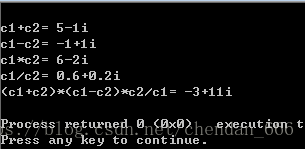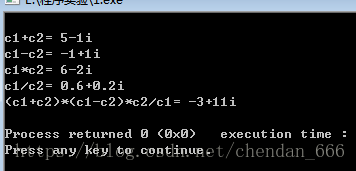实验目的和要求
熟悉运算符重载的定义和使用方法
实验内容
1.调试下列程序
//sy7_1.cpp
#include<iostream>
using namespace std;
class complex
{
public:
complex(){real=imag=0.0;}
complex(double r){real=r;imag=0.0;}
complex(double r,double i){real=r;imag=i;}
complex operator + (const complex &c);
complex operator - (const complex &c);
complex operator * (const complex &c);
complex operator / (const complex &c);
friend void print(const complex &c);
private:
double real,imag;
};
inline complex complex::operator + (const complex &c)
{
return complex(real+c.real,imag+c.imag);
}
inline complex complex::operator - (const complex &c)
{
return complex(real-c.real,imag-c.imag);
}
inline complex complex::operator * (const complex &c)
{
return complex(real*c.real-imag*c.imag,real*c.imag+imag*c.real);
}
inline complex complex::operator / (const complex &c)
{
return complex((real*c.real+imag*c.imag)/(c.real*c.real+c.imag*c.imag),(imag*c.real-real*c.imag)/(c.real*c.real+c.imag*c.imag));
}
void print(const complex &c)
{
if(c.imag<0)
cout<<c.real<<c.imag<<"i";
else
cout<<c.real<<"+"<<c.imag<<"i";
}
int main()
{
complex c1(2.0),c2(3.0,-1.0),c3;
c3=c1+c2;
cout<<"\nc1+c2= ";
print(c3);
c3=c1-c2;
cout<<"\nc1-c2= ";
print(c3);
c3=c1*c2;
cout<<"\nc1*c2= ";
print(c3);
c3=c1/c2;
cout<<"\nc1/c2= ";
print(c3);
c3=(c1+c2)*(c1-c2)*c2/c1;
cout<<"\n(c1+c2)*(c1-c2)*c2/c1= ";
print(c3);
cout<<endl;
return 0;
}写出程序的输出结果,并解释
实验结果如下:

2.调试下列程序
//sy7_2.cpp
#include<iostream>
using namespace std;
class complex
{
public:
complex(){real=imag=0.0;}
complex(double r){real=r;imag=0.0;}
complex(double r,double i){real=r;imag=i;}
friend complex operator + (const complex &c1,const complex &c2);
friend complex operator - (const complex &c1,const complex &c2);
friend complex operator * (const complex &c1,const complex &c2);
friend complex operator / (const complex &c1,const complex &c2);
friend void print(const complex &c);
private:
double real,imag;
};
complex operator + (const complex &c1,const complex &c2)
{
return complex(c1.real+c2.real,c1.imag+c2.imag);
}
complex operator - (const complex &c1,const complex &c2)
{
return complex(c1.real-c2.real,c1.imag-c2.imag);
}
complex operator * (const complex &c1,const complex &c2)
{
return complex(c1.real*c2.real-c1.imag*c2.imag,c1.real*c2.imag+c1.imag*c2.real);
}
complex operator / (const complex &c1,const complex &c2)
{
return complex((c1.real*c2.real+c1.imag*c2.imag)/(c2.real*c2.real+c2.imag*c2.imag),(c1.imag*c2.real-c1.real*c2.imag)/(c2.real*c2.real+c2.imag*c2.imag));
}
void print(const complex &c)
{
if(c.imag<0)
cout<<c.real<<c.imag<<"i";
else
cout<<c.real<<"+"<<c.imag<<"i";
}
int main()
{
complex c1(2.0),c2(3.0,-1.0),c3;
c3=c1+c2;
cout<<"\nc1+c2= ";
print(c3);
c3=c1-c2;
cout<<"\nc1-c2= ";
print(c3);
c3=c1*c2;
cout<<"\nc1*c2= ";
print(c3);
c3=c1/c2;
cout<<"\nc1/c2= ";
print(c3);
c3=(c1+c2)*(c1-c2)*c2/c1;
cout<<"\n(c1+c2)*(c1-c2)*c2/c1= ";
print(c3);
cout<<endl;
return 0;
}
写出程序的输出的结果,并解释。
程序结果如下;

3.定义一个Time类用来保存时间(时、分、秒),通过重载操作符“+”实现两个时间的相加(sy7-3.cpp)
分析与讨论
结合上题中的程序总结运算符重载的形式。
实验总结
首先,本次实验的基础是必须了解并掌握模板的概念,而模板的类属参数由调用实际参数的具体数据类型替换,并由编译器生成一段真正可以运行的代码,而这个过程叫做实例化。其次,函数模板的重载也使我们必须掌握的知识点,函数模板有很多的重载方式,可以定义同名的函数模板,提供不同的参数和实现,也可以用其他非模板函数重载。综合书上的理论知识,运用在实验中分析程序,利用实践加深我们对课本知识的学习,所以实验对我们的帮助还是很大的。























 1610
1610

 被折叠的 条评论
为什么被折叠?
被折叠的 条评论
为什么被折叠?








